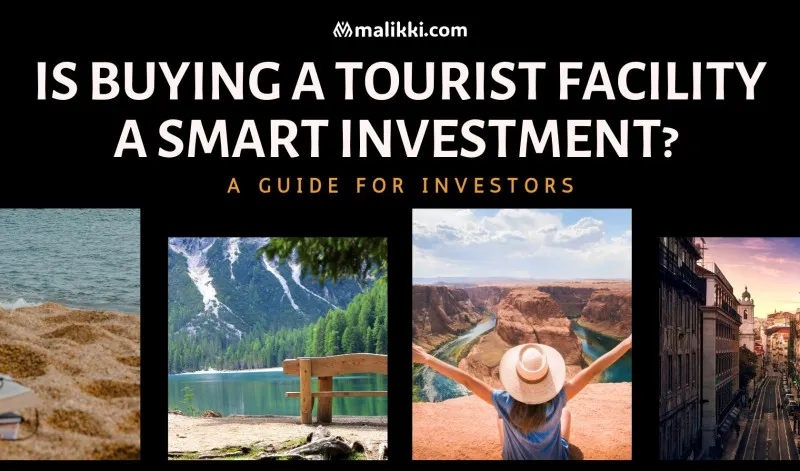Is Buying a Tourist Facility a Good Investment? A Guide For Investors
Investing in a tourist facility whether it's a hotel, resort, vacation rental or serviced apartment can be a highly lucrative opportunity. With global travel demand steadily increasing, tourism real estate offers high rental yields, property appreciation, and diverse revenue streams. However, it comes with risks, including seasonal demand fluctuations and high operational costs.
In this guide, we’ll explore whether buying a tourist facility is a smart investment, the benefits and challenges, and the key factors to consider before deciding
Why Invest in a Tourist Facility?
1. High Revenue Potential
Tourist properties generate more income than standard long-term rental properties. They benefit from short-term stays, allowing owners to charge premium prices during peak travel seasons.
- Luxury resorts and beachfront hotels can maximize profits through premium pricing.
- Short-term rentals, like vacation homes and serviced apartments, often yield higher nightly rates than long-term leases.
- Additional services—such as dining, entertainment, and excursions—offer extra revenue streams beyond accommodation.
2. Consistent Demand in Popular Destinations
Properties located in high-demand tourist destinations tend to have steady occupancy rates, ensuring reliable income.
- Top tourist hotspots (beaches, historical cities, ski resorts) attract visitors year-round.
- Well-connected locations with airports, public transport, and attractions boost demand.
- Some facilities cater to business travelers, offering year-round bookings.
3. Property Value Appreciation & Inflation Hedge
Investing in tourist real estate is a hedge against inflation, as property values typically rise in growing travel destinations.
- As tourism increases, land and property values appreciate, boosting long-term investment returns.
- Real estate in sought-after locations is often resistant to economic downturns compared to other industries.
4. Multiple Revenue Streams
Unlike traditional rental properties, tourist facilities can generate revenue from various sources, including:
- Room bookings: nightly or weekly rentals.
- Food & beverage services: restaurants, bars, catering.
- Event hosting: weddings, business conferences, retreats.
- Activity partnerships: tour operators, wellness centers, adventure tourism.
5. Personal Use Flexibility
Many investors use their tourist properties for vacations while renting them out for income the rest of the year. This provides both financial gains and lifestyle benefits.
Challenges of Investing in a Tourist Facility
1. Seasonal Demand Fluctuations
Tourism is highly seasonal in many destinations, leading to inconsistent cash flow.
- High income during peak season, but lower occupancy rates in the off-season.
- Economic downturns or political instability can affect tourist inflow.
Solution:
- Attract off-season guests (business travelers, digital nomads, long-term stays).
- Offer discounts or promotions during slower periods.
2. High Maintenance & Operating Costs
Tourist facilities require frequent maintenance due to high guest turnover, which increases costs for:
- Cleaning and housekeeping.
- Furniture and appliance upkeep.
- Staffing and operational management.
Solution:
- Invest in high-quality, durable materials to reduce long-term costs.
- Hire an efficient property management company to streamline operations.
3. Intense Market Competition
In major tourist hubs, investors face competition from hotels, resorts, and short-term rental platforms like Airbnb.
Solution:
- Differentiate your facility by offering unique experiences (eco-tourism, luxury retreats, wellness packages).
- Focus on niche markets (family vacations, business stays, adventure tourism).
4. Legal & Regulatory Challenges
Some locations have strict regulations on short-term rentals, zoning laws, or tax requirements.
Solution:
- Research local property laws and licensing before investing.
- Work with real estate attorneys to ensure compliance.
How to Make a Smart Investment in a Tourist Facility
1. Choose the Right Location
The success of a tourist facility heavily depends on location. Look for areas with:
- Strong tourism demand and rising visitor numbers.
- Close proximity to airports, attractions, and public transport.
- Government support for tourism infrastructure and development.
2. Conduct Market Research
Understanding travel trends and demand is crucial. Look at:
- Tourist preferences (luxury vs. budget accommodations).
- Competition analysis (hotel occupancy rates, pricing trends).
- Government policies (tax incentives, tourism development plans).
3. Assess Financial Viability
Calculate expected returns before purchasing a tourist facility:
✔ Projected rental income (based on occupancy rates and seasonal pricing).
✔ Operational expenses (maintenance, staff wages, utilities).
✔ Return on Investment (ROI) – ensuring positive cash flow and long-term appreciation.
4. Maximize Profitability with Diversification
To increase revenue, consider adding:
✔ On-site dining and bars to attract guests and local visitors.
✔ Wellness services (spa, yoga retreats, fitness programs).
✔ Event spaces for weddings, corporate retreats, and conferences.
5. Work with Industry Experts
Investing in a tourist facility requires expertise in real estate, hospitality, and tourism management. Consider hiring:
✔ Real estate agents to find profitable properties.
✔ Hospitality consultants to improve guest experiences.
✔ Property management companies to handle day-to-day operations.
Key Takeaways:
- Tourist facilities can generate high income but require strategic planning.
- Location is critical – invest in destinations with steady tourist demand.
- Financial planning is essential – analyze costs, ROI, and market trends.
- Diversify revenue sources to stay competitive.
- Work with professionals to ensure legal and operational success.
Ready to Invest in a Tourist Facility?
If you’re considering investing in tourism real estate, start by researching high-demand destinations and evaluating financial feasibility. A well-managed tourist property can be a profitable long-term asset in the booming travel industry!





